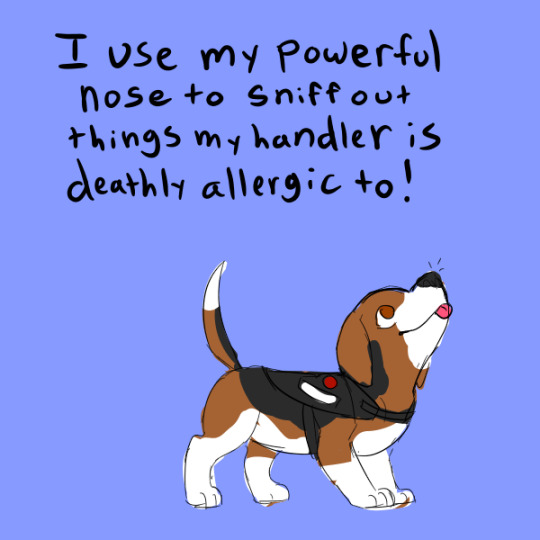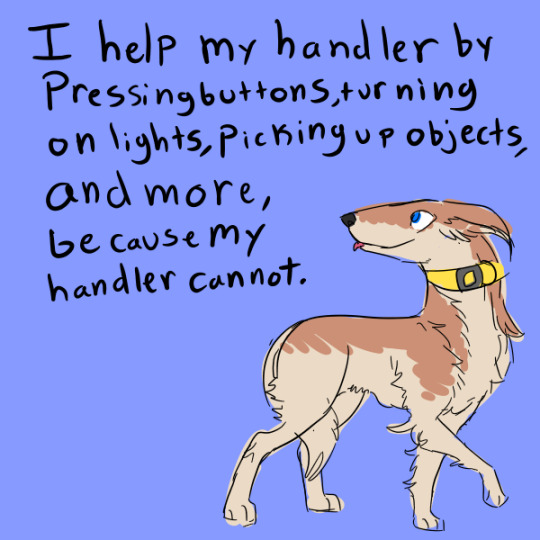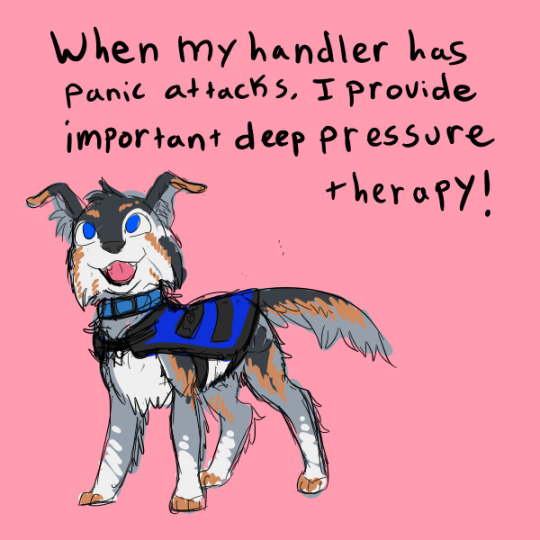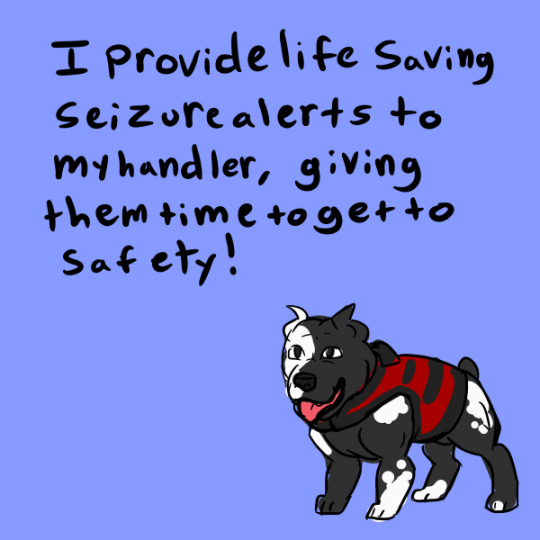Photo

In the USA service dog registries don’t have any legal standing because they can be done by anyone. They are scams to get money. for a service dog to be a service dog the handler must have a disability as defined by the ADA and the dog must be trained to mitigate that disability. when people flash that registry badge it results in more public access challenges for the rest of us. It results in people thinking a dog must have a registration and causes lots of stress for everyone involved.
559 notes
·
View notes
Text
Stress signals in dogs...and why they are important!!
I was watching a video the other day of a service dog in training. He was heeling beautifully beside his handler in a department store, sitting on command, performing a long distance down stay, and just being a really good dog. The handler wrote a short bit about how proud she was for how well her puppy was doing with his public access training. However, my heart truly breaks for this dog.
What the handler failed to realize is how completely uncomfortable her dog was to be there. Despite him behaving near flawlessly, his body language was screaming he’d rather be anywhere but where he was right then. Unfortunately many dog owners fail to notice subtle, yet key, signs of stress for their dog. Without knowing how to read subtle changes in body language, you can easily cause your dog to go from mildly nervous or uncomfortable, to a full on panic or rage in a matter of seconds. This is what happens when people say their dog “just had a meltdown,” or even snapped at someone, for “no reason.” Ignoring stress signals is incredibly dangerous for everyone involved.
When out training with your service dog (or your pet dog for that matter), it is important to get into the habit of carefully watching your dog’s body language. It helps to write down in a training log exactly how your dog reacts to different stimuli. This way, you will be able to clearly see where your dog is solid, where your dog is not, where you are improving, and where you need more work.
Below are signs of minor stress signals for dogs.
When I say minor, this doesn’t mean you should continue what you are doing in hopes he will just “get over it.” What I DO mean is that these are the signals which are almost always overlooked… when key stress signals are overlooked by the handler, it can lead to much greater problems.
Lip licking when no food is present
Yawning when he didn’t just wake up
Rapid sniffing of the air or ground
Stiff movement or tense muscles
Slowed movement or a laggy heel
Lowered tail
Hyper vigilance (rapidly moving eyes trying to scan the environment)
Hardened facial features
Dog stops taking treats/food
Dog starts taking treats in a more hard/bitey manor
Hard eyes (fast/sharp blinking)
Weight shift changes
Panting when it’s not hot out
Slightly roached (curved) back
Ears back
Not responding to handler’s commands
Looking away from handler
Whiney and uneasy
Nibbling on treats but not actually eating them
Leaning on the handler
Scratching themselves
Now here are some major stress signals for dogs.
If your dog is experiencing any of these, it is not only time to remove him from the situation ASAP, but to also rethink your training plan. Many of these signals will occur just shortly before a complete panic and/or bite.
Tightly tucked tail
Whale eye (dog’s eyes go wide and you can see the white rim around them)
Pulling towards an exit
Pulling away from the handler
Spinning on the leash
Not responding to the handler’s commands
Not responding to the handler’s voice
Shaking
Urinating
Low/tucked body position with a roached (curved) back
Sweaty paws
Whining
Heavy breathing when it’s not hot out
Teeth chattering
Tense lips and incisors (front teeth) showing while licking at the air
Laying down on the ground with their chin down and not wanting to move
Your service dog depends on you JUST as much as you depend on him. As your dog’s handler, you are 100% responsible for his mental and physical well-being at all times. No matter what situation you find yourself in, your dog’s needs should always come first.
Pushing a nervous dog into a situation where he is uncomfortable is one of the absolute worst things you can do for your SDiT, and creates the potential for much greater behavioral issues further down the road. Thinking your dog can “just get over it” is an extremely outdated training tactic. Just because your dog appears to stop fighting does NOT mean he is comfortable in that situation… it simply means he has shut down. He’s still anxious and afraid, but he’s decided there’s no point in fighting anymore. This is one of the most dangerous situations your dog may find himself in. He appears “calm,” but a second later has the potential to lash out and bite.
I get it, we are all excited to start public access training! However, the goal for service dog training should always be to create a mentally sound and stable dog in all situations. Subjecting him to situations which cause him fear or panic is just NOT the way to do that.
4K notes
·
View notes
Text
Dogblr giveaway!!!
Hey dogblrs,
I recently bought some cool stuff for a person I am no longer associating with. I don’t have a use for these toys anymore, so I’m going to give them away!! They are both BRAND NEW and still in the original packaging. They have never been used!
https://www.amazon.com/Outward-Hound-Kibble-Interactive-Puzzle/dp/B006ZTTSNK

https://www.chewy.com/outward-hound-invincibles-minis-dog/dp/50838

I’ll also include a bag of Zuke’s Turkey and Cranberry Trees treats and a few other surprises.
Here’s the deal. I’ll pay shipping to the continental United States. If you are outside of the US, you must be willing to pay for half of the shipping estimate.
To enter, simply like this post and reblog it to your dogblr account. You do not need to be following me.
On my birthday, Feb. 7th, I’ll use a random number generator to select a winner. Your ask box must be open so I can contact you!
228 notes
·
View notes
Text
So I’ve been spending all day trying to figure out how I’m going to bring Bandit with me to the mall tomorrow when I don’t have a purse to carry his stuff, and I just realized...
He has a backpack. He can carry it himself.
0 notes
Text
I’m worried that I can’t train Bandit on my own. But the only trainer where I live who works with SDs doesn’t do psychiatric SDs for people who don’t have PTSD. So I’m pretty much screwed.
0 notes
Photo

About
What is a SD?
Service Dog Law
Everything you need to know before training
Things that make a SD unsuitable
printable and downloads
General Advice:
1
2
3
4
5
6
Training
Getting started
11 Tricks to Teach a Dog
How to clicker train
First 5 skills to teach an SD
List of things to include in socialization
5 vital public access skills
Public Access test videos
Task training general
leash walking and heeling
Phase 1-4 training videos
Distress response
Focus and Impulse control
Basic training article
Hand signals
more basics
clicker training tips
many training articles
“stay” tips
training blog
using treat “levels”
training a rescue dog
training a herding/hunting dog
Day to Day
School with an SD
How to be a good Service Dog team
How to handle an access challenge
Gear
Head to toe recommendations
vest I use currently and will use
fun/funny/colorful SD patches
more patches
even more patches
another vest option
617 notes
·
View notes
Photo
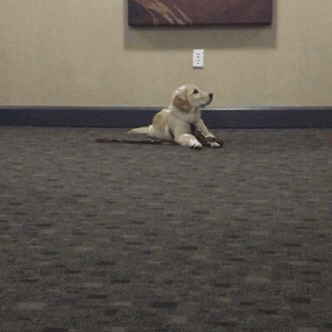
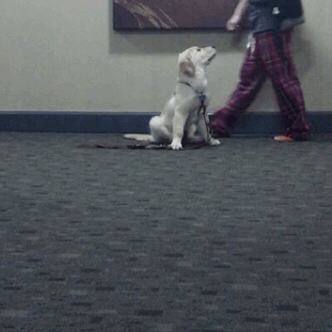

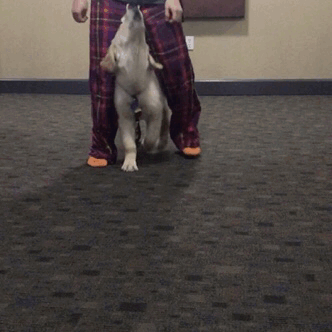
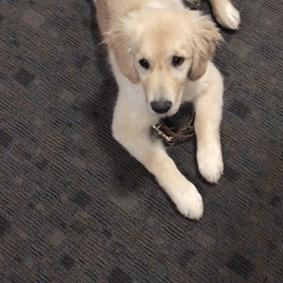

Training drills!
Every day we practice our “drills”. Thus far they include down/stay with people walking around and over him, sit/stay with people walking around him and his person being out of sight, “center” with walking forward and backward at his persons pace, “leave it” with food and toys, and “touch” from different positions and distances!
This serves a couple of purposes: it makes him think through problems (which wears him out much faster than running around), it reinforces cue-behavior match, and it is a good warm-up for learning new tasks. These are all things you can (and in my opinion should!) teach a pet dog too!
263 notes
·
View notes
Text
The Duality of Dogs
My dog when in my room: Trying to eat the corner of my dresser, pawing constantly at his kibble bin, tossing toys onto my laptop, constantly pressing F11, an actual hurricane
My dog when out working: Perfect heel, ignores food, sits when I stop walking, will lay down for extended times when I am busy, could probably fly if I asked him too
481 notes
·
View notes
Text
I’d thought I’d mention this since i just had to educate a business on facebook.
There is no “certification” for a service dog. Any who claim to have certification are more than often fake. And if a business asks for certfication kindly remind them that per the Ada businesses are only allowed to ask two questions. “Is this a service dog” and “what tasks are he or she trained to perform to mitigate your disability” anything else is setting your business up for a lawsuit. And one I’d gladly file if neccesary. What makes a service dog a service dog are the tasks that they are trained to do. There is no scrap of paper or special badge.
73 notes
·
View notes
Text
DO NOT interact with service dogs while they're working
DO NOT make eye contact or stare
DO NOT take pictures or video
DO NOT touch
DO NOT make noises
honestly this should apply to all dogs that aren’t yours but distracting a service dog is a CRIME; it can and does ENDANGER THE HANDLER
2K notes
·
View notes
Photo

This is one of my favorite clicker games, and I couldn’t find a good visual for clients so I made one.
The idea behind it is to get your dog thinking creatively and generate new ways to interact with the box to earn rewards. It’s great for free shaping behaviors if you want to teach things like agility, tricks, etc. It also serves as a confidence boosting exercise for nervous dogs and puppies. Fun, simple, cost-effective, and dogs who haven’t done a lot of work like this are usually exhausted by the end.
More detailed instructions here: http://www.clickertraining.com/node/167
7K notes
·
View notes
Text
Help me get a power chair!
Hey guys! My knee pain is getting worse and I can’t propel a manual wheelchair any farther than I can walk because of my shoulder pain. Right now I have no idea how I’m going to get to class or get groceries. My only hope is getting a power chair, but I can’t afford one on my own.
I’m looking at the Airhawk folding power wheelchair, which is on sale for about $2000. I should be able to transport it and it’ll give me the freedom I need.
You can donate at the links below! If you can’t donate I’d really appreciate you sharing!
PayPal.me/Sabrina938
https://www.youcaring.com/brigorden-910195?utm_campaign=buttonshare&utm_medium=url&utm_source=copy&utm_content=cf_cp_01
Thank you!
89 notes
·
View notes
Text
Bandit isn't big enough to pull my chair, so if I can't get an electric one I'm really screwed
0 notes
Photo


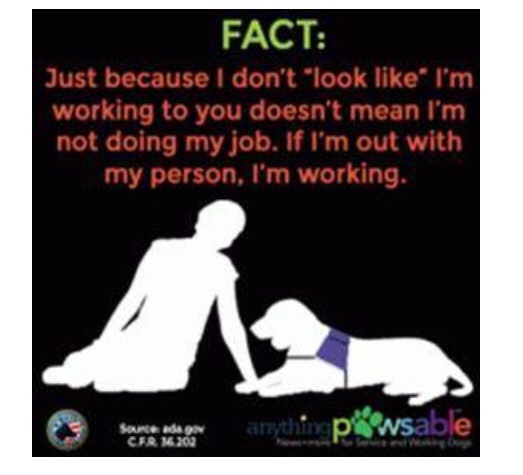
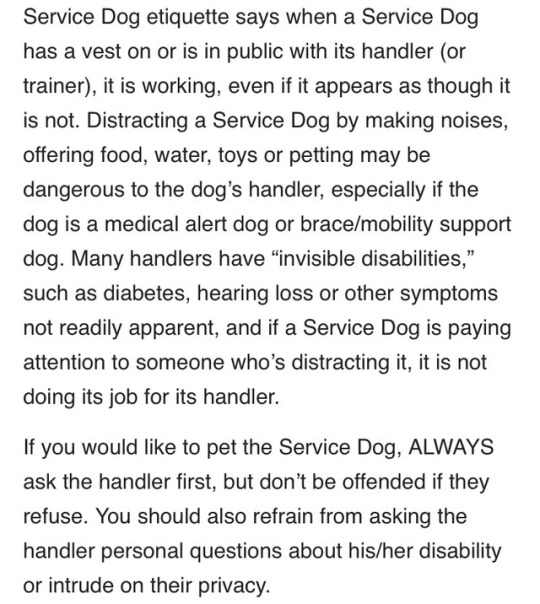
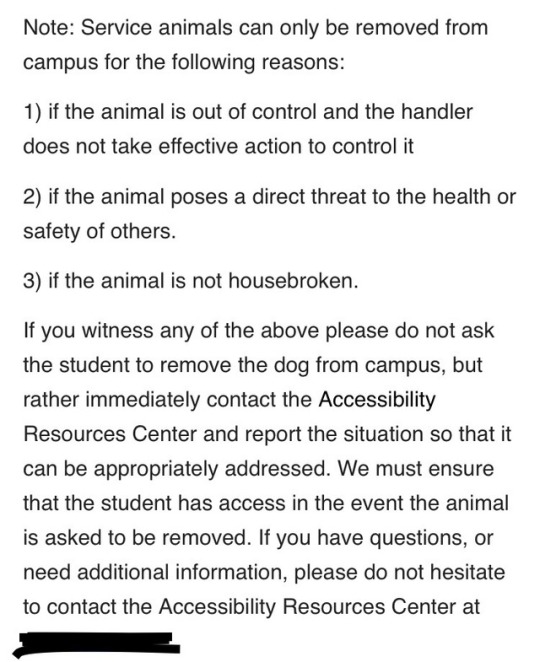
My University sent out this PSA about service dogs on campus, and I felt that it was a very good introduction to the dos and don'ts of interacting with service dogs.
128 notes
·
View notes
Text
Why your dog will only come when it feels like it, and what you can do to change that
Recall (or coming when called) is something that a lot of people have trouble teaching effectively. I practice recall with students in every level of dog training class that I teach, and by the higher level classes, practice looks pretty tough. We scatter toys, chew hooves and other tempting items around the practice area, allow the dogs to become interested, and then promptly call them away and back to us. Pretty impressive!
What surprises a lot of people is that the same dogs who perform tough exercises like this in class are oftentimes unable to be off leash outside, and in many cases will even ignore owners who call them from a fenced yard. They’ve learned that in controlled situations, coming when called is typically their best option - they get a treat out of it, after all! Additionally, during training class their owners are usually all-business and practice exactly as they should.
The problem is, many owners have a habit of practicing by-the-book in class and making little mistakes at home. Even owners who take their dogs out for practice sessions throughout the week can easily forget the rules during their day-to-day life. These are some of the most common mistakes I observe, and explanations of why they are so damaging.
1. “Come” leads to punishment or other undesirable outcomes
This can mean two things. In the first type of scenario, a dog learns that coming when called is followed by something unpleasant. For instance, a dog owner wakes up in the morning, puts her dog in the yard, gets ready for work, then goes to collect the dog to put him in his crate before she leaves for the day. The dog learns that after “come”, he goes into the crate - especially if this routine is common. The dog decides he’s much better off poking around in the yard for a few more minutes and starts ignoring the owners requests. Until recalls are reliable (though ideally, not even then), dogs should never be called before crating, nail trims, or other undesirable activities.
In the second scenario, an owner calls the dog but it doesn’t come (or doesn’t come immediately). When it finally makes it back or when it’s retrieved, the owner harshly scolds the dog for not responding like it should have. This is absolutely counterproductive as it tells the dog that returning to the owner leads to being punished. If a dog thinks that this is what happens when they are called, they will naturally be disinclined to listen!
2. “Come” is not a single cue, but a collection of words and noises
Everything we teach our dog must have a cue to make it happen. For instance, “sit”, “down”, or “shake”. In this case, it could be “come” or “here” or anything else that will be easy for you to remember. However, for many people, what starts as “come” often turns into “Come! C'mere! Come on, pup! Lets go! Come on!” This phenomenon is incredibly common, yet nobody would tell their dog to do anything else with such fuzzy or random cues. If you want your dog to come every time it is called, pick a cue and stick to it - otherwise you can expect poor reliability.
3. “Come” is made ignorable
If you aren’t convinced that your dog will respond when you call it, then don’t! The reason being, if we do and the dog chooses to ignore us, he learns instantaneously that he CAN ignore this command. It’s pretty simple. Sometimes I catch people starting to ask me how they can make their dog come to them if they can’t call it - and I remind them that if their dog could come when it was called, we wouldn’t be having this conversation. Until recalls are reliable, zip your lips and get your dog to you another way. If necessary, make a “no words” policy and use whistles, kissy noises, hand claps or excited “pup pup!” sounds to encourage your dog along.
Sessions for training “come” should be planned. Dogs should be on a long training line (something lightweight, so that they’re not really aware they are leashed) while practicing. If we say “come” and the dog ignores us to sniff a bush (or whatever), we can begin to shorten the line to retrieve the dog. The dog learns that he cannot ignore this command, and if he does, we’ll just remove him from the reinforcement he was hoping to find elsewhere. However, if he does listen, he gets praise and a treat party!
4. Marking “come” at the wrong time
Many people will wait until the dog arrives at their feet to mark (verbally or with a clicker). The problem here is that “come” should be met with an immediate response from the dog. By waiting until they arrive to praise them, many owners unintentionally communicate to their dog that they can do whatever they’d like after the owner calls, as long as they eventually come.
Once recall practice has started we need to let our dogs know that they have a very short amount of time to respond. We should strive to see immediate recognition of the command - so mark the moment they turn and start moving toward you. Most dogs who have been in training before this point will hear their mark and already be on the way to you for a reward, which is also helpful.
Once the dog arrives you only need to provide the anticipated reward. However, many owners will mark a second time upon the arrival of the dog to say “yep, this is where you stop. Thanks!” For instance, if I find that a dog comes reliably but stops too far away from me, I’ll raise criteria by marking for moving closer to my feet until they “land” where they should.
5. Owners “go after” the dog, and the dog becomes evasive
A dogs oppositional reflex is powerful. If we move towards a dog, they back further away. If we step away from a dog, they move towards us. Many people make moves toward a dog they are trying to call and unintentionally compel the dog to back away. If a dog seems reluctant to come when called, the trainer should move (if not sprint) away from the dog after calling it. It may sound counterintuitive, but believe me on this one!
It is also important to pay attention to your body language. Do not face a dog who seems reluctant to come head-on. Turn slightly away from the dog to appear more approachable - and squatting down usually doesn’t hurt either.
So, moving onto what you SHOULD do…
1. Build enthusiasm
When a dog hears “come”, we want them to be turned towards us by the time we’re done saying it. To get that kind of speed it sure helps to have enthusiasm!
Many dogs have issues with recall since in many cases they’re already in forward motion - perhaps even chasing something. Many dogs hate losing momentum, so teach them that if they fly back to you there’s more fun to be had!
One way we teach this is through a game called skitterball. To play skitterball, call your dog as usual, but instead of handing them a treat when they arrive, roll or throw it away from you. Most dogs quickly gain speed in their recall once they realize that they could miss a flying treat! Another way you can gain speed is by calling your dog, marking as soon as they turn, and immediately running in the opposite direction. Your dog will probably run to catch up, and in doing so, learn that “come” needs to be fast.
2. Teach impulse control
Most dogs have little trouble with recall during a training session - they get the pattern and they know that they will be rewarded, so why not? But being called out of distracting activity or away from something interesting is a totally different story.
A firm foundation of obedience and practice in any behavior involving impulse control (stay, wait, leave it, etc) will help, to start. Our dogs need to learn that sometimes they’ll have to “just say no”. These are two of my favorite impulse control exercises which relate to teaching come:
-In the first exercise, start with your dog on a standard 6’ lead. Hold it firmly.
-Take a treat and throw it just out of your dog’s reach.
-Your dog will presumably pull towards the treat. As they’re straining on the leash, call them. “Skippy, come!”
-Do not repeat your verbal cue if the dog does not respond. If the dog is unresponsive and does not stop straining towards the treat after being called after 30 seconds or so, begin to gently pull the dog away from the treat. Don’t jerk them away harshly, since we ultimately want the dog to make the decision to come. If we rely on the leash to get a response there will be no reliability without it.
-The instant your dog turns to you, regardless of how long it took (for now - that rule changes down the line), mark. If your dog is moving towards you slowly, jog backwards to encourage them to gain speed. Once they make it to you, treat and praise heavily!
This exercise can be mixed-up by throwing toys, by practicing around dogs, or (for people-loving pups) by having a helper stand out of the dogs reach while verbally engaging him / her (“hey puppy! Hey bud! Whose a good pup?!”).
Another game that I play is find it / come. This is a fun one, and helps to build both enthusiasm and impulse control.
-Start by tossing a few treats onto the ground. Point to the treats and instruct your dog to “find it!”
-As soon as they seem to be finishing with the treats, call them excitedly.
-Mark the moment they turn to you, and praise / reward when they make it to your feet.
-Practice this way several times, and once your dog is immediately responding to your cue you can try making it tougher. Either pretend to throw a treat (if your dog will fall for it) or deliberately toss treats into taller grass or the edge of a bush to make them difficult to find.
-At this point we’re roughly simulating the frustration a dog may feel while deciding whether to come or to blow off their owner in order to do something else (chase a rabbit, continue playing with another dog, etc). The first few times a dog may be slow to respond, so be sure to utilize backup techniques if necessary. For instance, if you call once and your dog looks at you but isn’t moving yet, try a backwards jog. Or if your dog listens but clearly isn’t happy about it, “skitter” your treats once they get to you instead of handing them to build excitement. Most dogs will start to come pretty quickly, even when pulled out of this frustrating situation, because finding the treats might be tough but the treats they get for responding are guaranteed.
-After repeating that step until your dog comes back from the frustrating treat-tosses quickly, make it even harder. Scatter treats in a more obvious area, and like before, ask your dog to “find it” - but this time, call the dog back before they can finish eating them all. Make sure that “come” is crisp, friendly, and said excitedly!
-If you try this and your dog is insistent upon finishing the treats before responding, quickly gather the treats they’re trying to eat or simply say “oops!”, take their leash, and walk them away. When you first try this it’s best to toss something less appealing (like dry dog food) but offer high-value rewards (hotdogs, chicken, freeze-dried liver, etc) for recall to give the dog incentive to respond. As they get better with this exercise, you can vary the reinforcement they receive and call them away from more tempting items.
A few more tips….
Dogs should be on a training lead until they’re fully reliable so that we’re always able to retrieve them quickly. This way, they get the message that ignoring us doesn’t mean that they’ll be able to evade us for long. When they’re off leash, ignoring us provides precious moments (or minutes, in some cases) of freedom, and the inevitable chase that ensues between a loose dog and it’s owner is often all the reinforcement a dog needs to run away. To teach our dogs that they can’t ignore our commands, we first need to make that true by maintaining control.
Also, don’t persue your dog while trying to teach come. Many owners find themselves trying to “keep up” with their dog - frequently calling them back and making sure they can’t go too far or out of sight. Instead, we should aim to teach our dogs that they need to keep an eye on us if they want to explore.
One way this can be done is by playing hide-and-seek. If you have a nervous dogs who panics when you’re out of sight, this usually isn’t necessary (and could actually be quite cruel). But if you have a dog that will run away without looking back, it’s not a bad idea to teach them that they could easily get lost - and that finding yourself alone is quite scary.
With your dog in a safe fenced area or on a long training line, practice recall a few times to set a positive tone and encourage attentiveness. Next encourage your dog to independently explore, run, and sniff. When they seem occupied, discreetly jump behind a bush or tree and “spy” on them. Once they realize that they’re alone most will pause, look around, and perhaps panic visibly. Wait for a bit to see if your dog can find you on his own, but if they seem to be struggling immensely or going the wrong way, whistle, “pup pup!’”, make kissy noises, etc, to help them find you. Once they do, throw a party. Happy voices, verbal praise, and plenty of treats!
Another way we can encourage dogs to pay attention is by changing direction erratically from time to time. Walk through a field, parking lot, or other large area at a brisk pace. When your dog picks up speed and is ahead of you, turn around or change direction. Give them some time to notice and change direction with you (try not to resort to calling until you’re going to run out of training line), and if they do, toss them a treat as they run past you. I like to encourage dogs to a) follow my lead and keep an eye on my whereabouts and b) make occasional “drive-by” runs to check in with me, so these direction-changing drills help teach both. As the dog starts to keep up and check in more often you can absolutely start to vary the frequency with which you actually offer a treat, until all you need is a quick “thank you” pat or verbal praise.
On that note, as you’re practicing you may begin to wonder when you can stop using treats. The best answer is that you shouldn’t. Not completely, anyway. If your dog has practiced recall reliably for several sessions, you should absolutely begin to vary your rate of reinforcement. If you’re doing well, give something like this a shot:
- Call your dog. Mark and provide a treat. Repeat 3-5 times.
-Call your dog. Mark, but when your dog arrives, verbally praise and pat them instead of giving a treat.
-Call your dog, mark and treat.
-Call your dog, mark, give a brief positive acknowledgement before moving on.
-Call your dog, mark and have a tugging or fetching session.
… And mix it up from there! Once your dog is reliable you can certainly cut back back on the number of treats you offer, but if your dog begins making mistakes or seems to be losing interest, raise your rate of reinforcement until it’s doing well again. Try to end sessions on a high note!
As a final tip, for all but perhaps the very first session or two, treats should be concealed in your pocket or a bait bag and only removed once your dog has received a mark. By not calling your dog while food is visible, you avoid the possibility of finding yourself in a situation in which your dog refuses to come because he doesn’t see a treat your hand!
“Come” is a potentially life-saving command. Most owners will find themselves in a heart-stopping situation at some point in which they watch as their dog runs into the woods, towards a busy road, or straight at an unfamiliar dog. I know how terrifying these moments are, but I also know how much easier they are to absorb and handle when you can simply remember to yell “come!” and have your dog stop, turn to you, and run up to your feet. That peace of mind is absolutely worth working for. Recall is a serious cue, but it’s also a ton of fun to teach, so practice often and enjoy it. If you really need it some day, you’ll be glad you did!
8K notes
·
View notes
Text
There are days when I am blessed to have my dog and there are also days in which he is blessed to have me, because somebody else would have drop kicked him off a bridge by now
2K notes
·
View notes

